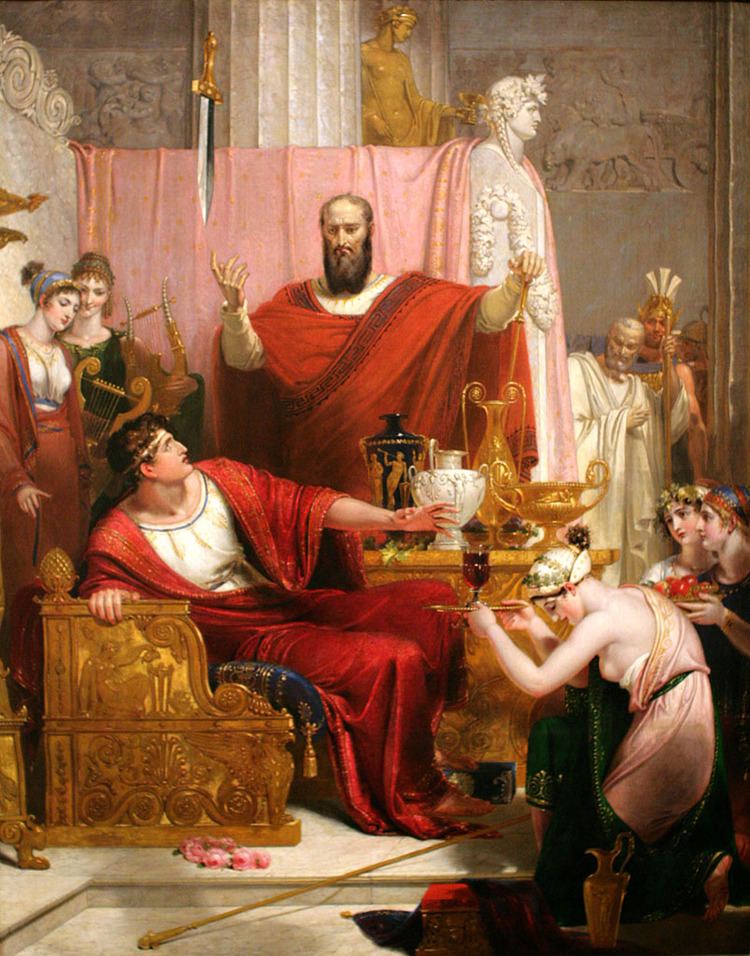Name Dionysius of | Parents Dionysius I of Syracuse Children Apollocrates | |
 | ||
Role Dionysius I of Syracuse's son Similar People Dionysius I of Syracuse, Damocles, Agesilaus II, Richard Westall | ||
Dionysius II of Syracuse
Dionysius the Younger or Dionysius II (c. 397 BC – 343 BC) was a Greek politician who ruled Syracuse, Sicily from 367 BC to 357 BC and again from 346 BC to 344 BC.
Contents
Biography
He was the son of Dionysius the Elder. When his father died in 367 BC, Dionysius began ruling under the supervision of his uncle, the philosopher Dion. Dion's disapproval of the young Dionysius's lavishly dissolute lifestyle compelled him to invite his teacher Plato to visit Syracuse. Together they attempted to restructure the government to be more moderate, with Dionysius as the archetypal philosopher-king (see the Seventh Letter of Plato).
However, under the influence of opponents of Dion's reforms, Dionysius conspired with the historian Philistus and banished his uncle, taking complete power in 366 BC. Without Dion, Dionysius's rule became increasingly unpopular, as he was mostly incompetent in governing men and commanding soldiers. When Plato appealed for Dion's return, the irritated Dionysius interfered with Dion's property and finances and gave his wife to another man. Before this, Dion's Syracusan estates had financed his peaceful and comfortable life overseas in Athens, but Dionysius's last offence spurred him into action.
Dion formed a small army at Zacynthus and returned to Sicily in 357 BC, much to the delight of the Syracusans. As Dionysius was in Caulonia, Italy at the time, Dion took all but Syracuse's island citadel easily. Dionysius sailed back to Syracuse immediately, attempted attacks from the citadel and tried to negotiate peace treaties. When he was unsuccessful in all attempts, he sailed to Locri and left the citadel in the hands of his son Apollocrates.
While in exile, Dionysius took advantage of the friendly citizens of Locri and became the city's tyrant, treating the locals with great cruelty. He did not return to Syracuse until 346 BC, eight years after Dion's assassination by his officers. Soon after he left Locri, the locals drove out the remaining troops and took their revenge on Dionysius's wife and daughters. Dionysius, who was still unpopular, was able to regain power in Syracuse only because of its great political instability. In the preceding years many other cities in Sicily defected from Syracuse and were ruled by local tyrants. Several of these cities joined the Syracusans in an attack against Dionysius which proved to be quite successful. Dionysius was forced back into the citadel. At this time, 344 BC, Timoleon arrived and began his invasion of Sicily. Dionysius, out of respect for Timoleon and aware he no longer had a chance of victory, arranged the surrender of the citadel and was given safe passage to Corinth. Dionysius died in the following year in Corinth, where he lived in increasingly miserable conditions.
In popular culture and literature
Dionysius is one of the central characters in the legend of the Sword of Damocles.
Dionysius also appears in Dante's Inferno, in which he is referred to as "Dionysius of Sicily" in Canto 12. He is among the many souls named by Chiron that boil in blood for violence against others.
The Renaissance alchemist Michael Maier relates a legend about Dionysius II in his book Atalanta Fugiens (1617), where he was shipwrecked at the Gulf of Corinth, and without his swimming skills he could have never reached the shore. At Corinth, although he lived poorly, he became a teacher. Maier uses this legend as an allegory to explain a certain point in the Magnum opus, when the "philosophical subject" (the stone) must ascend to the surface of the "philosophical water".
Dionysius also features in Mary Renault's The Mask of Apollo.
